‘Never trust a man with a balloon’: the aerial photography of the Guildhall amphitheatre
Ian Blair
For inexplicable reasons now lost in the mists of time, a man with a balloon (with I assume a camera slung beneath it on an umbilical),as opposed to a Montgolfier brothers style balloon launch from the Guildhall Yard, had been booked to take aerial photographs of the Roman amphitheatre, something that perhaps for very good reason, had never been tried before on an archaeological site in the City of London.
Anyone who has worked on a large archaeological excavation will testify to the amount of preparation required for site wide photographs, often taking from a few days to several weeks. The latter was certainly the case with the Guildhall amphitheatre in 1993, when, with all the archaeology excavated in the arena and eastern entranceway, the preserved masonry walls of the amphitheatre and the whole site was then immaculately photo-cleaned, in advance of the critical end of site aerial photography.
The morning of the photography dawned, and the roof structure was peeled back over the massive steel props to reveal the amphitheatre in all its glory for the first time, the scaffold walkway through the props having been removed earlier. Jim Crooks, the nice but no-nonsense Mancunian construction manager for the Guildhall Yard East project, had given us a morning to complete the final photography, with a promise that at high-noon his attendants were then going to start excavating pits in the arena area for new props, so the clock was ticking.
Our work done, we waited the arrival of the balloon man, who somewhat worryingly there was no evidence of when we arrived on site, and then the worst news possible filtered through, that he had cancelled. I remember my expression on hearing the news, as it was caught on celluloid by a film crew from ‘Rapier Productions’ who the Corporation of London had commissioned to document the Guildhall Art Gallery development, a mix of pure frustration and supressed rage, at us all being let down so abysmally at this final juncture, and with our collective efforts now precariously balanced on a knife edge as the clock ticked ever onwards.
Given that the main area excavation had effectively finished by this point, and Nick Bateman (the site director) had departed for his holidays, it fell to Angus Stephenson (the project manager) to pull out all the stops, get on the blower, and find another means of facilitating the aerial photography post-haste. Phone calls rapidly made, he managed to locate and hire a truck mounted cherry picker with a long telescopic boom, which duly arrived in time to save the day and undoubtedly avert one or two red faces. Quite why such a well-established, proved, and tested means of facilitating the taking of aerial photographs on archaeological sites, was passed over in favour of a man with a balloon is an enigma, but perhaps someone on high in MoLAS at the time had undeclared shares in dirigibles.
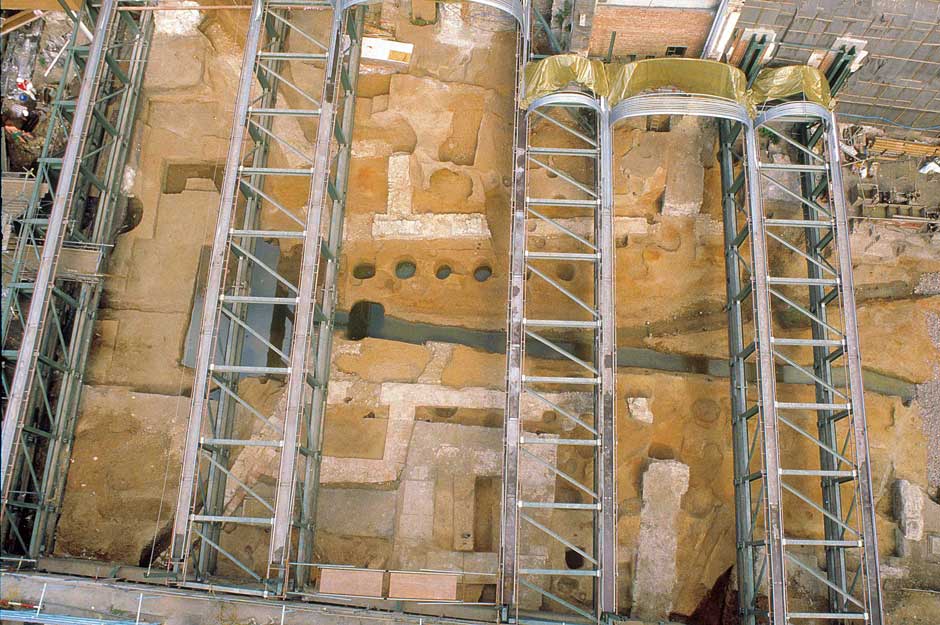 The early 2nd century masonry amphitheatre from on high looking north. The arena is on the left defined by the curving walls, with the east entrance leading off to the right, flanked by chambers on either side. The wooden drains and silt traps have been lifted and are marked by the water-filled channels.
The early 2nd century masonry amphitheatre from on high looking north. The arena is on the left defined by the curving walls, with the east entrance leading off to the right, flanked by chambers on either side. The wooden drains and silt traps have been lifted and are marked by the water-filled channels.
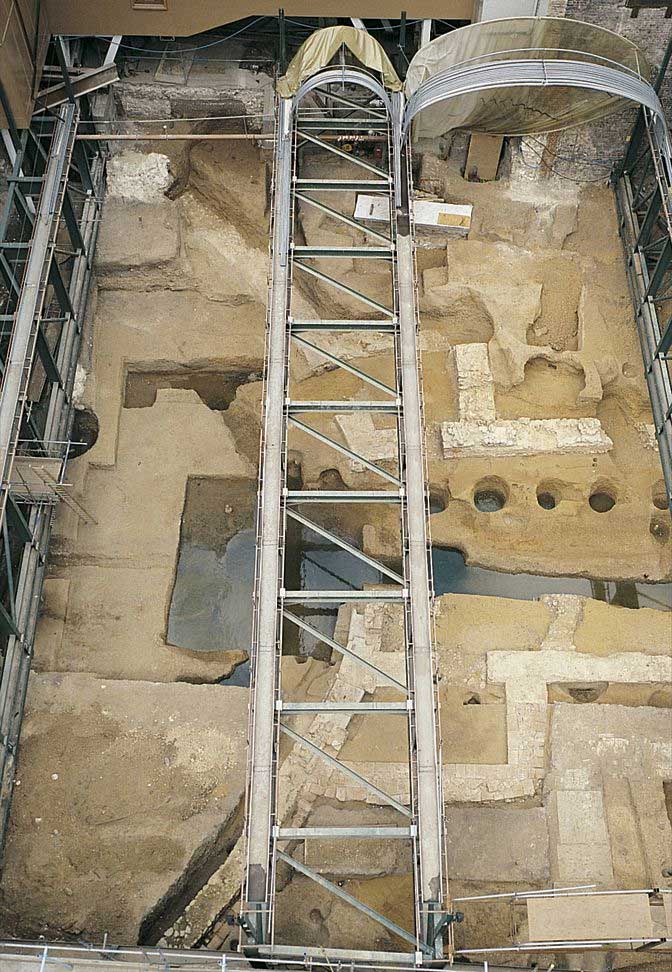 The amphitheatre arena on the left with the two side-chambers flanking the east entrance likely to have been shrines or changing rooms. The line of five large post-pits at right centre are associated with the earlier timber amphitheatre built in AD 70.
The amphitheatre arena on the left with the two side-chambers flanking the east entrance likely to have been shrines or changing rooms. The line of five large post-pits at right centre are associated with the earlier timber amphitheatre built in AD 70.
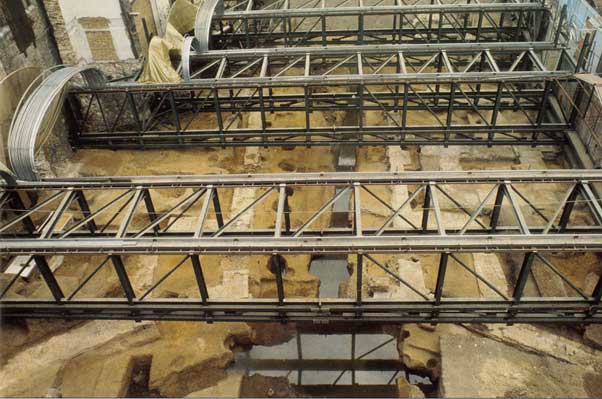 View of the amphitheatre looking east from the Guildhall Yard. The arena is in the foreground with the east entranceway and side chambers in the middle of the photograph. I have often mused that it would have been impossible to have chosen a better location for the site, given the wonderful symmetry of the remains, and the fact that it encompassed so many key elements of the amphitheatre. Clearly fate or kismet was on our side.
View of the amphitheatre looking east from the Guildhall Yard. The arena is in the foreground with the east entranceway and side chambers in the middle of the photograph. I have often mused that it would have been impossible to have chosen a better location for the site, given the wonderful symmetry of the remains, and the fact that it encompassed so many key elements of the amphitheatre. Clearly fate or kismet was on our side.
photographs by permission MOLA; © MOLA
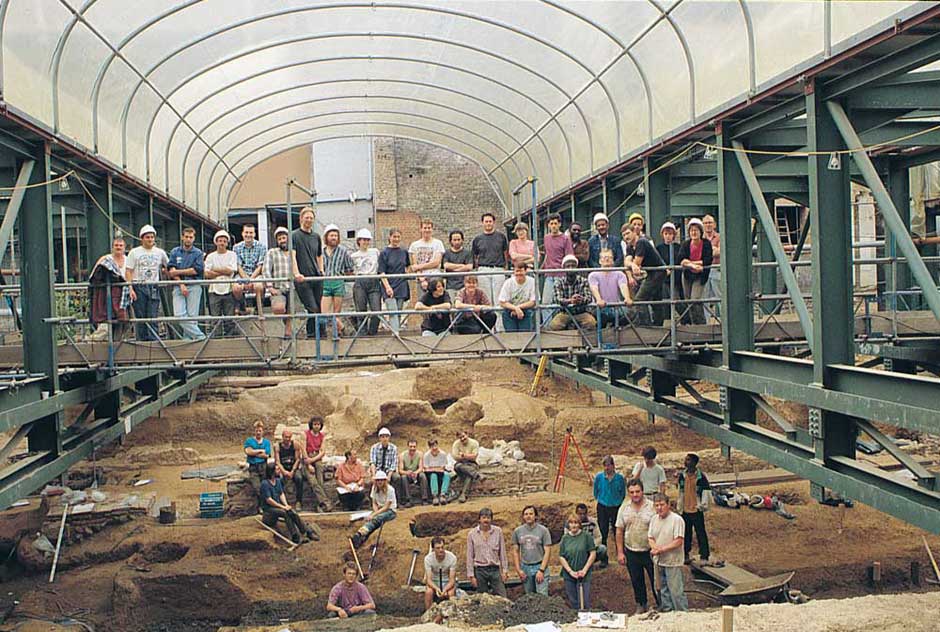 The amphitheatre team towards the end of the main area excavation. The scaffold walkway where most of the archaeologists are standing, provided access across the site through the centre of the massive steel props, and was removed in its entirety to facilitate the aerial photography at the end of the site.
The amphitheatre team towards the end of the main area excavation. The scaffold walkway where most of the archaeologists are standing, provided access across the site through the centre of the massive steel props, and was removed in its entirety to facilitate the aerial photography at the end of the site.

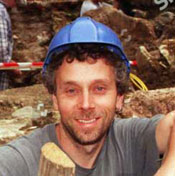

Comments powered by CComment